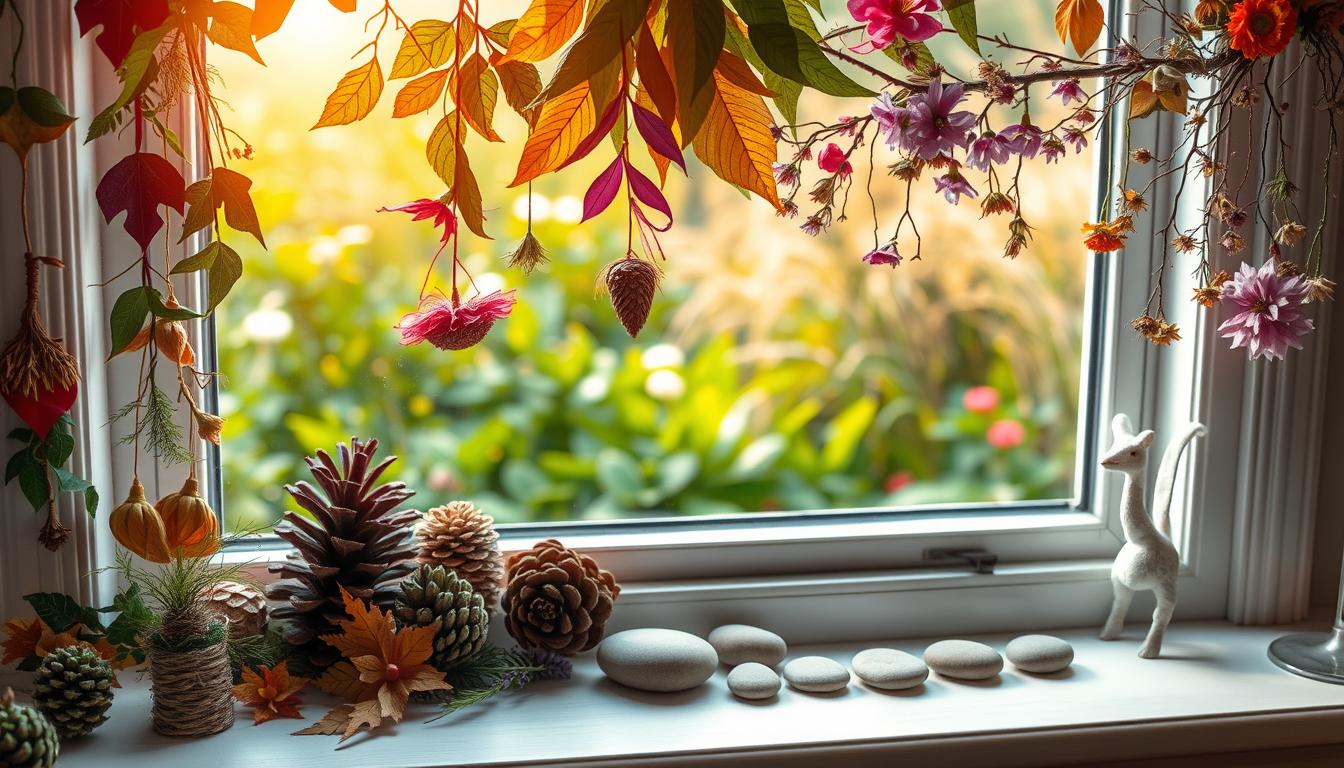Nature Crafts for Kids
“The earth is what we all have in common. It is what we pass on to our children—and creativity is how we help them cherish it.” – Wendell Berry’s words capture the heart of artistic exploration outdoors. Imagine turning pinecones into paintbrushes or transforming fallen leaves into vibrant collages. These activities aren’t just projects—they’re invitations to see the world differently.
Every season becomes a treasure hunt. Spring offers budding flowers for pressed-art bookmarks, while summer beaches provide shells for mosaic designs. Autumn’s acorns become whimsical figurines, and winter’s bare branches transform into rustic frames. Best of all? Materials cost nothing—just step outside and explore.
These experiences blend fresh air with focused creativity. Children learn to observe textures, colors, and shapes in their environment, sparking both curiosity and calm. Parents appreciate the simplicity: no expensive kits or complicated tools required. Just imagination and the great outdoors.
Key Takeaways
- Free creative projects using materials found outdoors
- Seasonal ideas from spring flower art to winter stick sculptures
- Combines physical activity with artistic expression
- Encourages observation of natural patterns and textures
- Accessible for all skill levels and budgets
Introduction to Outdoor Creativity
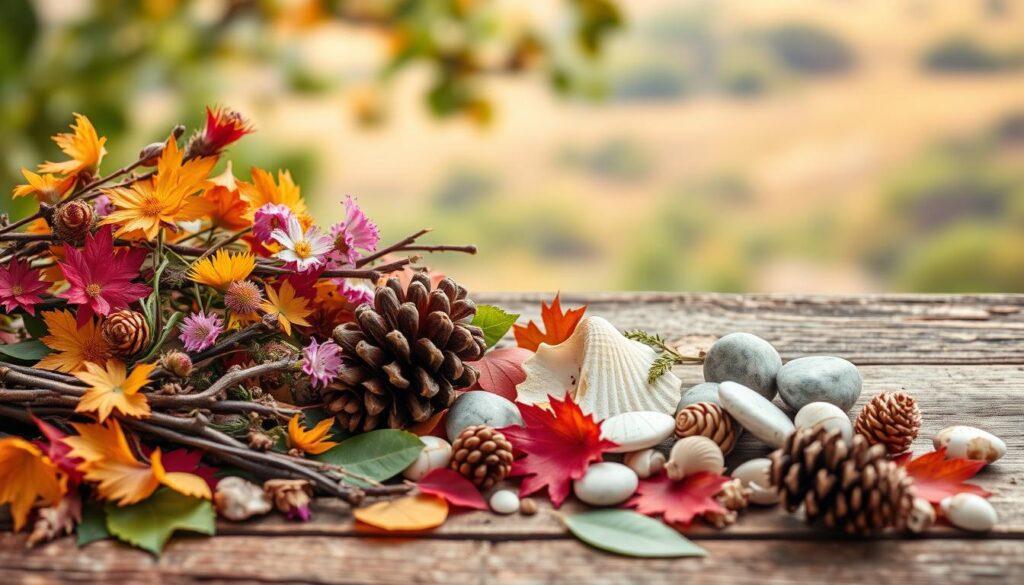
Creative sparks fly when little hands meet earth’s raw materials. The world outside isn’t just a playground—it’s a studio where fallen leaves become stencils and pebbles transform into puzzle pieces. This approach turns ordinary walks into discovery missions, where children learn to see possibilities in every twig and stone.
Why Nature Inspires Art
Natural elements like jagged bark or feather-light seeds engage multiple senses at once. A pinecone’s ridges teach about patterns, while seashells reveal spiral geometries. These textures push young creators to experiment—balancing smooth stones in sculptures or weaving grasses into dreamcatchers. No two projects look alike, since every material has its own quirks.
A Brief Overview of Natural Materials
Seasons dictate the artistic palette. Winter’s bare branches work as frames or mobiles, while summer beaches offer shells for mosaics. Even “awkward” items like spiky sweetgum balls become stamping tools with paint. Best part? Supplies renew themselves monthly—no need for shopping lists.
Handling these treasures has hidden perks. Sorting acorns by size builds focus, and twisting vines into shapes calms restless minds. It’s art class meets mindfulness practice, all under an open sky.
Nature Crafts for Kids: Getting Started
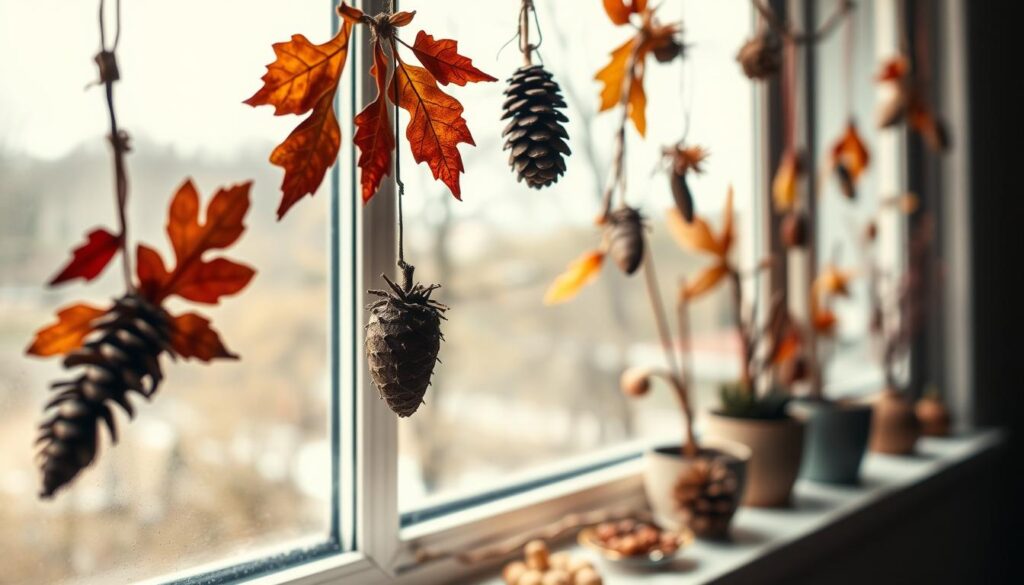
Outdoor creativity begins with simple tools and curiosity. Gather child-safe adhesives like low-temperature glue guns and washable PVA glue. Add string, hole punches, and elastic bands to connect sticks, leaves, or shells. These basics turn backyard finds into whimsical mobiles or window decorations.
Safety comes first. Always rinse rocks, pinecones, and twigs in soapy water before use. Teach little ones to avoid sharp edges and handle tools under adult watch. Glue guns work best for ages 6+, while preschoolers can safely use cotton twine or clay.
Collect materials mindfully. Take fallen items only—never pick live plants. A good rule? Fill one small basket per walk. This keeps projects manageable and protects ecosystems.
| Material | Storage Tip | Freshness Window |
|---|---|---|
| Leaves & Flowers | Flat between book pages | 1 year (pressed) |
| Pinecones | Mesh bag in cool area | 6 months |
| Sticks & Bark | Open basket in dry space | 3 months |
Match projects to skill levels. Toddlers enjoy sorting acorns by size, while older kids tackle stick forts. Let them sketch ideas first—a crumpled leaf might inspire a window suncatcher! Designate a craft zone with wipeable mats for messy fun.
Benefits of Crafting with Natural Materials

Hands-on projects using organic resources do more than fill time—they shape young minds. Research shows combining outdoor activity with creative tasks boosts mental clarity and physical coordination. These experiences turn scattered leaves or pebbles into tools for growth, offering rewards far beyond finished artworks.
Enhancing Creativity and Fine Motor Skills
Sorting acorns or threading twigs demands precision. Small hands gain strength while arranging delicate seeds, preparing them for writing and detailed tasks. Three-dimensional projects, like balancing stick sculptures, sharpen spatial reasoning and problem-solving abilities.
Irregular shapes—crooked branches or asymmetrical stones—teach adaptability. “There’s no ‘wrong’ way to use what you find,” says a preschool art teacher. This freedom builds flexible thinking as children invent solutions on the fly.
Building a Connection with the Outdoors
Screen-free activities with natural materials foster calm focus. A study found 73% of kids showed improved attention spans after weekly nature-based sessions. Collecting pinecones or weaving grasses becomes meditative, reducing stress through rhythmic repetition.
| Benefit | Supporting Activity |
|---|---|
| Fine Motor Development | Seed sorting, shell threading |
| Cognitive Growth | 3D stick structure building |
| Emotional Balance | Leaf pattern repetition crafts |
These projects also nurture environmental care. Handling fallen leaves or weathered bark helps children appreciate ecosystems firsthand. Completed creations—like window decorations from pressed flowers—become pride-filled reminders of their capabilities.
“Working with organic elements engages both hands and heart, creating lasting bonds with our planet.”
Easy DIY Projects for Nature-Inspired Crafts
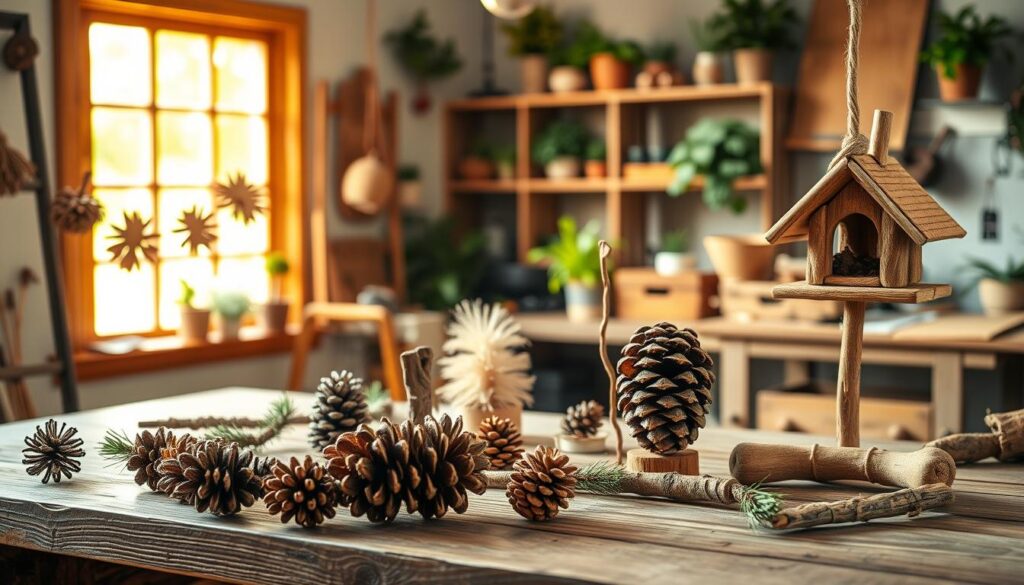
Transform backyard treasures into playful art with these simple pine cone and stick projects. These activities blend easy fun with hands-on learning, letting kids make creations that spark joy and curiosity.
Simple Pine Cone and Stick Creations
Start with pine cone hedgehogs – glue felt ears and googly eyes onto a cone for instant woodland charm. For outdoor-friendly crafts, mix peanut butter and birdseed to coat pine cones. Hang these edible feeders in trees to attract feathered friends.
Twigs become instant storytelling tools. Build stick people using rubber bands to connect limbs. Add yarn hair or fabric scraps for personality. Larger branches can frame seasonal collages – arrange autumn leaves or winter berries between crossed sticks.
| Project | Materials Needed | Seasonal Twist |
|---|---|---|
| Pine Cone Owl | Cotton balls, felt scraps | Add holly for winter |
| Stick Cabin | Hot glue, bark pieces | Use blossoms in spring |
| Nature Mobile | String, assorted finds | Incorporate seashells |
Sticky sap? Rub cones with vinegar before crafting. For wobbly stick joints, wrap twine tightly around connections. Let imaginations run wild – a lopsided pine cone might become a troll’s hat in storytime adventures!
These crafts adapt to any weather. Create snowy owls with white paint in January or beach-themed mobiles in July. The best part? Every project becomes a window into your child’s unique perspective.
Crafting with Seasonal Finds: Pine Cones, Leaves, and More
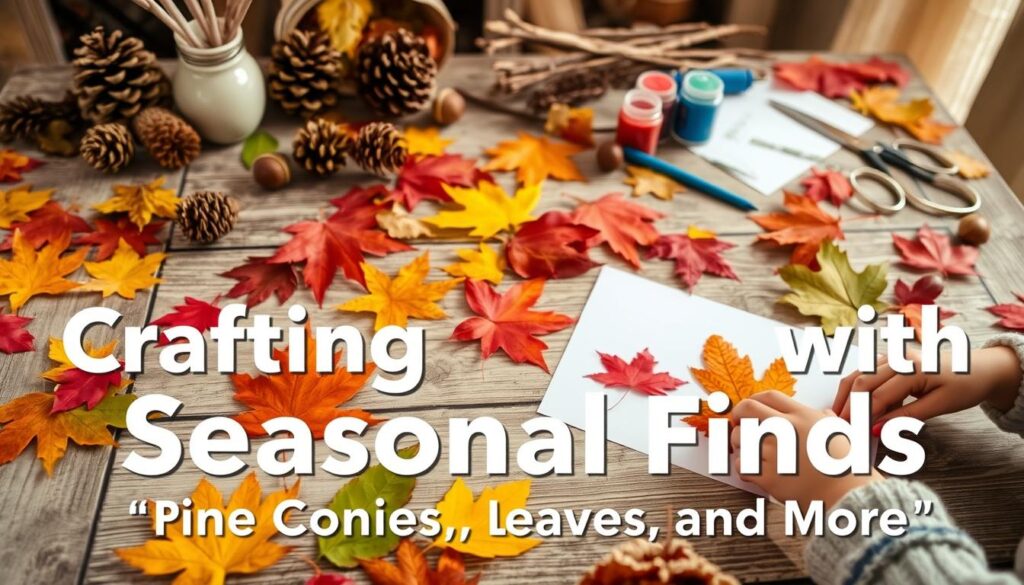
Seasonal shifts unlock endless possibilities for artistic adventures. From fiery maple leaves to frost-kissed twigs, each month brings fresh materials for imaginative projects. These activities blend hands-on learning with timeless traditions that families can revisit year after year.
Autumn Leaf Rubbings and Lanterns
Capture fall’s beauty through leaf rubbings – place vibrant foliage under thin paper and rub with crayons. Experiment with layered colors to highlight unique vein patterns. Preserve favorite specimens by dipping them in beeswax, creating durable pieces for window displays.
Transform simple jars into glowing lanterns using Mod Podge and pressed leaves. Arrange maple or oak shapes in overlapping patterns, then seal with adhesive. “These luminous creations make magical centerpieces for autumn gatherings,” notes a seasoned art educator.
Winter Stick Crafts and Mobile Ideas
Bare branches become elegant mobiles when paired with pinecones and dried citrus slices. Use fishing line to hang elements at varying heights, creating movement that catches indoor light. For seasonal versatility, swap decorations monthly – add heart-shaped leaf craft cutouts in February or pastel eggshells in spring.
| Preservation Method | Materials Needed | Duration |
|---|---|---|
| Glycerin Soak | Leaves, water, glycerin | 3-6 days |
| Wax Paper Pressing | Iron, parchment paper | Instant |
| Silica Gel | Sealed container, desiccant | 1 week |
Create wearable art by weaving flexible twigs into circular crowns. Decorate with lichen clusters or acorn caps for woodland charm. These pieces encourage dramatic play while teaching about natural cycles through tactile exploration.
Creative Natural Material Projects: From Stones to Acorns
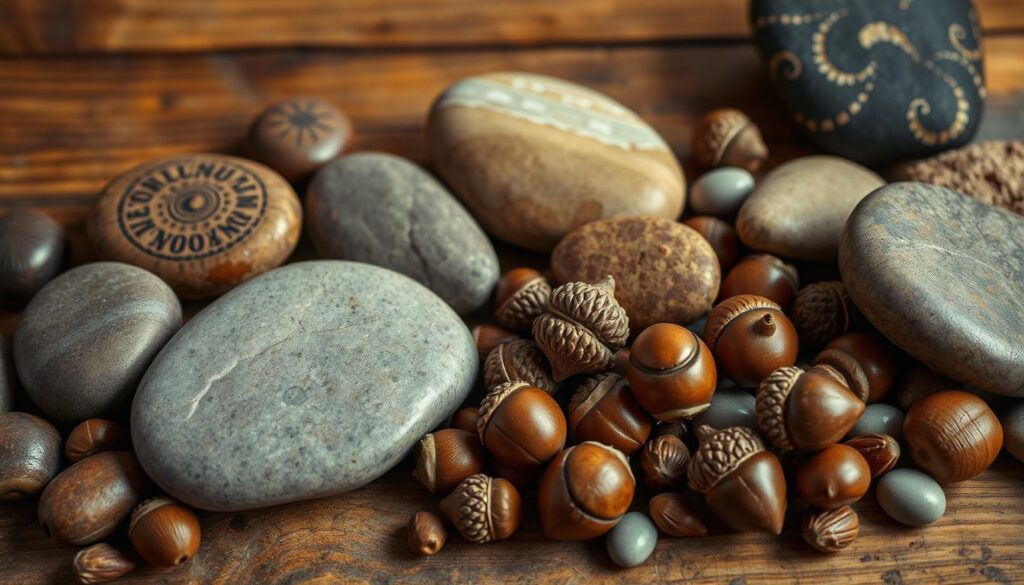
Earth’s simplest treasures become magical when viewed through creative eyes. Smooth stones transform into playful companions, while acorns evolve into tiny masterpieces. These projects celebrate raw beauty while teaching resourcefulness.
Stone Pets, Pendants, and Games
Turn beach finds into personality-packed stone pets. Let natural shapes guide designs—a pointy rock becomes a dinosaur, while a flat one makes a perfect turtle shell. Create glitter heart rocks by brushing glue along edges and sprinkling with sparkles. These make beautiful gifts that capture outdoor charm.
No-drill pendants? Easy! Wrap stones in colored wire, leaving a loop for stringing. Pair different sizes on leather cords for earthy jewelry. For group fun, paint ladybird spots on rocks to make a tic-tac-toe set. Use sanded wood slices as the game board.
Unique Acorn Crafts and Conker Creations
Acorn caps become dollhouse teacups when glued to tiny clay bases. Thread cleaned acorns onto elastic for woodland bracelets—add beads for extra color. Create wide eyes on acorn owls using white paint and marker dots.
Younger crafters love conker creatures. Stick googly eyes onto horse chestnuts and add pipe cleaner legs. For texture play, press conkers into clay to make imprints. Older kids can weave yarn around crossed sticks to create traditional God’s eyes decorations.
| Material Prep | Method | Tip |
|---|---|---|
| Stones | Scrub with soapy water | Air-dry completely |
| Acorns | Freeze overnight | Prevents insect issues |
| Conkers | Sand rough edges | Use 120-grit paper |
Display finished pieces near a window to catch sunlight. These crafts spark conversations about tree life cycles and rock formations—learning disguised as play!
Inspiring Ideas from Community Events and Nature Play
Communities bloom when families gather to transform ordinary materials into shared masterpieces. Public spaces become creative labs where garden workshops and seasonal festivals spark fresh play ideas. These events turn parks into galleries and backyards into collaborative studios.
Local Garden Workshops and Seed Mosaics
Neighborhood garden programs often host seed art sessions. Kids arrange lentils, beans, and sunflower seeds into intricate patterns on cardboard backings. For lasting pieces, brush diluted glue over finished designs. These collages become vibrant wall art or window decorations when hung with twine.
| Seed Type | Best For | Color Palette |
|---|---|---|
| Black Beans | Outlines & Contrast | Deep Earth Tones |
| Split Peas | Background Fill | Soft Greens |
| Quinoa | Texture Details | Golden Accents |
Vegetable Sculptures and Outdoor Festivals
Autumn fairs often feature veggie sculpting stations. Overripe zucchini becomes rocket ships, while bell peppers transform into grinning faces. Use toothpicks to connect pieces—it’s edible engineering! “These activities make food exploration exciting,” shares a festival organizer.
School programs take it further. Students mold clay bugs adorned with acorn caps or pine needles. For group projects, try paper plate animal masks decorated with pressed flower petals. Attach elastic ties for instant playtime costumes.
| Material | Prep Tip | Project Idea |
|---|---|---|
| Cardboard | Pre-cut shapes | Leaf-Frame Masks |
| Paper | Use recycled sheets | Seed Packet Art |
| Vegetables | Select firm varieties | Tower Building |
Share creations at neighborhood swap meets or through window displays. These gatherings build connections while celebrating local inspiration. Snap photos of collages and sculptures to spark ideas year-round!
Conclusion
Gathering twigs and leaves can be more than play—it’s a bridge to wellness. Studies prove spending time outside boosts physical health and mental clarity. Simple craft ideas using natural elements turn backyard finds into tools for connection.
Arranging pinecones or weaving grasses becomes meditative. These activities help families unwind while creating something beautiful. Transform treasures into cheerful window displays that brighten any room—no kits required.
Exploring the world through hands-on projects sparks joy across generations. It’s also great for nurturing patience and observation skills. Each creation strengthens family bonds and deepens appreciation for our environment.
Ready to start? Step outside and let the land guide you. The benefits—from stress relief to creative growth—wait just beyond the door.
FAQ
What materials are best for outdoor art projects?
How can crafting help kids connect with the environment?
Are seasonal crafts adaptable for different skill levels?
What’s a simple project to start with?
Where can I find local workshops for nature play?
How do I preserve delicate items like leaves for collages?

Adam Peter is a finance, travel, and automotive writer with over a decade of experience. He creates clear, practical content to help readers manage their money, explore the world with confidence, and make informed decisions about cars and travel gear. His work blends expert insight with real-world usefulness.

